All About Grey Squirrels - Grey Squirrel Facts & Information
About Grey Squirrels
Grey squirrels, scientifically known as Sciurus carolinensis, are charismatic and adaptable creatures that have become a ubiquitous presence in the United Kingdom. Originally native to North America, these squirrels were introduced to the UK in the late 19th and early 20th centuries. Their introduction has had significant ecological and conservation implications, particularly in relation to the native red squirrel (Sciurus vulgaris) population.
Despite their non-native status, grey squirrels have managed to thrive in the UK's diverse landscapes. Their ability to adapt to various environments, coupled with their opportunistic feeding habits, has allowed them to establish themselves in both urban and rural areas. Their presence in local parks, gardens, and woodland areas has made them a familiar sight to residents and visitors alike.

However, the success of grey squirrels has come at a cost. Their introduction has had a negative impact on the native red squirrel population, which has suffered a decline in numbers due to competition for resources and the transmission of squirrelpox virus. Grey squirrels are more efficient at finding and utilising food sources, which has given them a competitive edge over their red counterparts.
Despite their controversial status, grey squirrels remain a subject of fascination and intrigue. Their adaptability, intelligence, and acrobatic antics make them a popular choice for wildlife enthusiasts to observe and study. Furthermore, ongoing research into their behaviours and interactions with the environment continues to shed light on the complex dynamics between introduced and native species, offering valuable insights into the challenges of conservation in an ever-changing world.
Defining characteristics
Grey squirrels are easily recognisable by their soft, dense grey fur that varies in shades of grey, with hints of red and brown. Their large, bushy tails serve as both a means of communication and as a tool for balance while leaping between trees. Their front teeth, which grow continuously throughout their lives, are sharp and adapted for gnawing through a variety of materials, including nuts, seeds, and even tree bark.
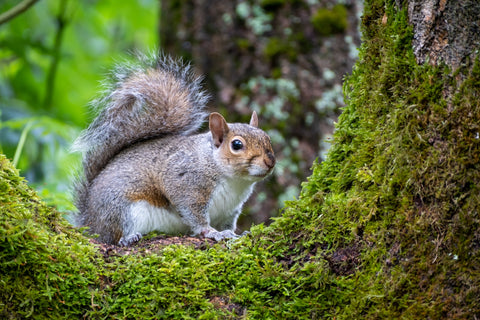
How long do Grey Squirrels live?
In the wild, grey squirrels generally have a lifespan of around 6 to 12 years, although many do not make it past their first year due to predation, accidents, and other environmental factors. Squirrels face a range of challenges throughout their lives, from finding sufficient food to avoiding predators such as hawks, owls, and domesticated animals.
Where did Grey Squirrels Come From?
Grey squirrels are native to North America, where they are a crucial part of various ecosystems. However, they were introduced to parts of Europe, including the United Kingdom, in the late 19th and early 20th centuries. Their introduction has led to complex interactions with native species and changes in local ecosystems.
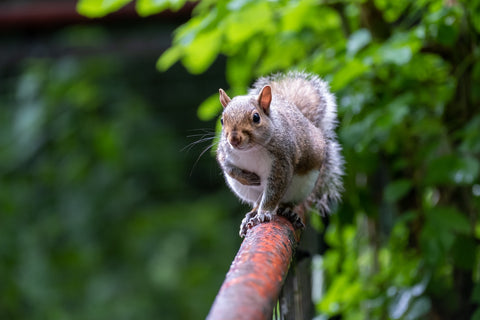
What do Grey Squirrels eat?
Grey squirrels' diverse diet and charming behaviour make them a delightful addition to any garden. While they are known for their agility and resourcefulness in finding food, providing them with supplementary nourishment can offer an exciting opportunity for observation and interaction. Squirrel feeders are perfect if you're looking to attract them to your garden!
What to Feed Grey Squirrel
-
Nuts and Seeds: Nuts like walnuts, hazelnuts, and almonds, as well as seeds like sunflower seeds, are excellent choices for feeding a grey squirrel. You can place these items in squirrel feeders or scatter them around your garden to mimic their natural foraging behaviour.
-
Fruits: Fresh fruits like apples, pears, and berries can be a delightful treat for grey squirrels. Make sure to cut the fruits into smaller, manageable pieces to make it easier for them to handle.
-
Vegetables: Squirrels occasionally nibble on vegetables like corn and carrots. Offering these in moderation can add variety to their diet.
-
Unsalted Nuts and Nut Butters: Unsalted peanuts, cashews, and peanut butter can provide essential fats and proteins for squirrels, especially during colder months.
-
Special Squirrel Feed Mixes: We offer specialised squirrel food mixes that contain a combination of squirrel nuts, seeds, and dried fruits. These can be convenient and nutritionally balanced options.
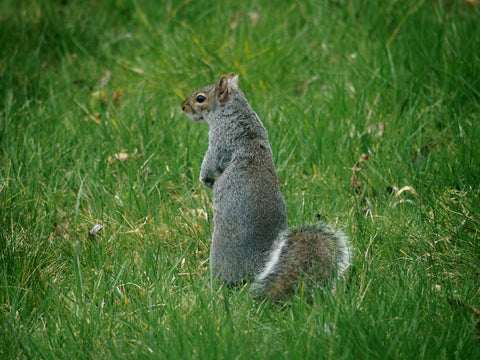
Feeding Guidelines and Considerations
-
Moderation: While feeding grey squirrels can be enjoyable, it's important to do so in moderation. Providing too much food can lead to dependency and impact their natural foraging behaviour.
-
Water Source: Along with food, ensure a source of clean, fresh water is available for the squirrels, especially during hot and dry periods.
-
Feeder Placement: Place squirrel feeders at a height that allows squirrels easy access while deterring larger pests like raccoons. Opt for feeders with squirrel-resistant features to prevent other animals from depleting the food.
-
Observation: Feeding grey squirrels provides a wonderful opportunity for observing their behaviours up close. You might witness their playful antics, social interactions, and even their impressive agility while navigating your garden.
-
Interaction and Respect: While squirrels may become accustomed to your presence, it's essential to remember that they are wild animals. Maintain a respectful distance, and never attempt to handle or approach them closely.
Feeding grey squirrels in your garden can offer a unique connection to nature, fostering a sense of appreciation for the wildlife that coexists alongside us. By providing suitable and healthy food options, you can contribute to their well-being while enjoying the delightful charm these creatures bring to your outdoor space.
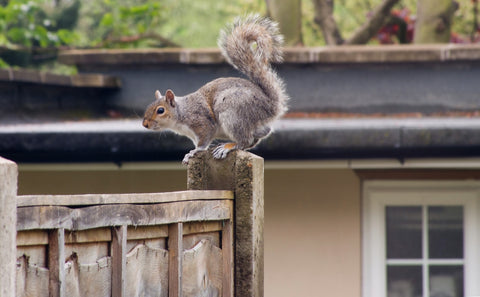
Male Grey Squirrels & Female Grey Squirrels
In terms of physical appearance, male and female grey squirrels are similar, making it challenging to distinguish them solely based on looks. However, during the breeding season, males may exhibit more territorial behaviour, including chasing other males away from potential mates. Female squirrels have a gestation period of about 44 days and give birth to litters of 2 to 4 kits on average.
Behavior
The grey squirrel is known for their energetic and agile behaviour. They are excellent climbers and jumpers, capable of leaping between trees and navigating urban structures with ease. Squirrels are also known to bury nuts and seeds in various locations, which helps them locate food during harsher times when resources are scarce.
Do Grey Squirrels kill Red Squirrels?
The interaction between a grey squirrel and a red squirrel is a contentious issue in many parts of Europe, where the introduced grey squirrel have outcompeted and displaced the native red squirrel (Sciurus vulgaris) population. While grey squirrel do not actively seek out red squirrels to kill them, they indirectly contribute to their decline by competing for resources and carrying a disease called squirrelpox virus, which doesn't harm grey squirrels but can be fatal to red squirrels.
In conclusion, grey squirrel are remarkable creatures with a range of intriguing characteristics and behaviours. Their ability to adapt to diverse environments and their interactions with other species highlight the complex relationships that exist within ecosystems. Observing these squirrels can provide valuable insights into the delicate balance of nature and the challenges of coexisting with introduced species.
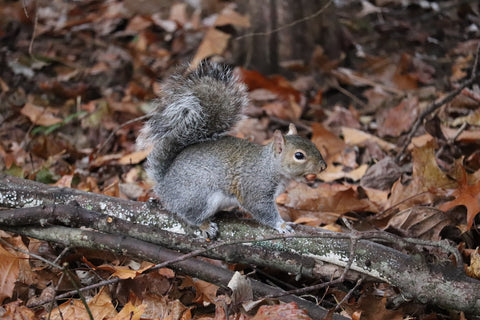
Grey Squirrels in the UK
Grey squirrels, those agile acrobats of the treetops, have firmly established themselves within the landscapes of the United Kingdom. Introduced from North America in the late 19th and early 20th centuries, these charming creatures have found an array of environments in the UK to call home. From city parks to countryside woodlands, their presence has stirred both wonder and concern.
Why were Grey Squirrels introduced to the uk
The introduction of grey squirrel to the UK was not without intention. In the late 19th century, a few individuals believed that the introduction of North American grey squirrels would add a touch of novelty and charm to the British landscape. These individuals imported and released these squirrels into estates and parks, setting the stage for an unexpected outcome.
The grey squirrels' adaptability and resourcefulness allowed them to thrive in their new environment. They quickly populated various habitats, outcompeting the native red squirrels for resources due to their larger size and more varied diet. Unfortunately, this competition, along with the transmission of squirrel-pox virus by the grey squirrel, has contributed to a significant decline in the red squirrel population in the UK.
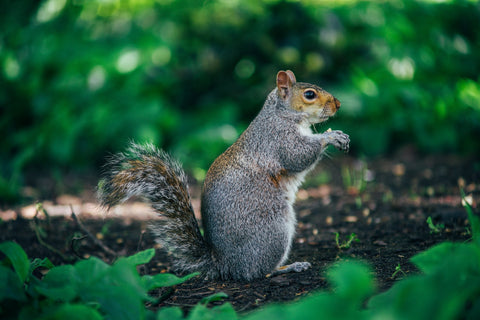
What are Baby Grey Squirrels Called?
Baby grey squirrels are called "kits" or "kittens." When born, these young squirrels or 'kits' are blind, hairless, and completely dependent on their mother's care. They remain in the nest, known as a "drey," for several weeks, gradually growing fur and developing the ability to open their eyes. Once they become more independent, they begin to explore the world around them under their mother's watchful eye.
Is it illegal to feed Grey Squirrels?
Feeding grey squirrels is not illegal in the UK; however, there are guidelines and considerations to keep in mind. While providing supplementary food can be a delightful way to engage with these creatures, it's crucial to do so responsibly.
Overfeeding can lead to health problems for squirrels and disrupt their natural foraging behaviours. Additionally, consider the potential impact on other wildlife and the environment when offering food. If you're feeding them from bird feeders then make sure you're not topping them up too frequently

Are Grey Squirrels Protected?
Grey squirrels are not protected under the Wildlife and Countryside Act 1981 in the UK. This lack of protection reflects the species' non-native status and the challenges they pose to the native red squirrel population. However, this doesn't mean that they are exempt from humane treatment. The Royal Society for the Prevention of Cruelty to Animals (RSPCA) advises treating all animals with respect and providing appropriate care if they are injured or in distress.
In summary, grey squirrels have found a second home in the UK, captivating onlookers with their acrobatics and adaptability. The story of their introduction and their subsequent impact on the ecosystem highlights the delicate balance between introducing non-native species and preserving native biodiversity. As we continue to share our spaces with these charismatic creatures, understanding their behaviours and ecological role can pave the way for responsible coexistence.
Five facts about Grey Squirrels
-
-
Colour Variation: Despite their name, the grey squirrel can exhibit a range of colour variations, from silver-grey to dark charcoal. Some individuals may even display hints of red or brown in their fur. This variation is influenced by genetics, diet, and environmental factors.
-
Memory Masters: Grey squirrel are known for their incredible memory and spatial cognition. They have the ability to remember the locations of hundreds of individual food caches, which they create by burying nuts and seeds. This memory skill helps them find food during lean times.
-
High Leapers: These agile creatures are excellent jumpers and can leap up to 10 times their body length to cover distances between trees or other structures. Their strong hind legs and long tails provide them with exceptional balance and propulsion.
-
Constant Chewers: Grey squirrels have strong, continuously growing front teeth that require constant use to prevent overgrowth. They gnaw on various objects, including tree branches, nuts, and even human-made items like cables and wires. This behaviour helps keep their teeth at a manageable length.
-
Communication through Tail Movements: Grey squirrels communicate not only through vocalisations but also through their tails. They use their tails to signal their intentions and emotions to other squirrels. For instance, a rapidly twitching tail might indicate agitation or excitement, while a fluffed-out tail can signal dominance.
-






